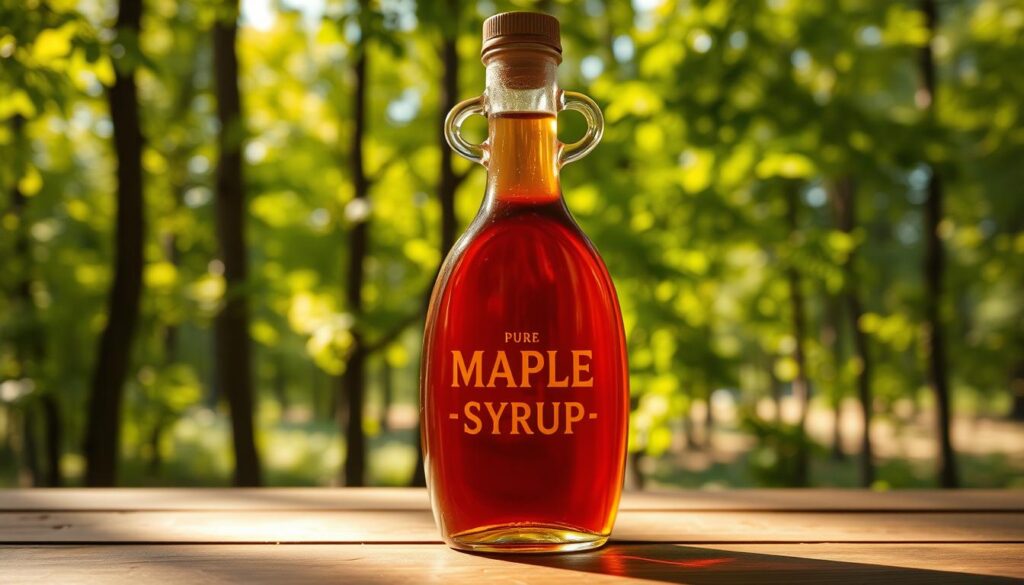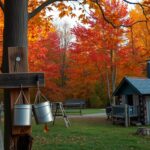In Vermont’s green hills, a sweet tradition flows through maple trees. Vermont maple syrup is more than a condiment; it’s a culinary treasure. Each golden drop shares a story of sugarmakers who turn tree sap into liquid gold.
Vermont maple syrup is different from other sweeteners. Its rich flavor comes from Vermont’s unique geography and old production ways. Sugarmakers tap trees at the right time, making dark, mineral-rich syrup with deep taste.
The magic starts in Vermont’s forests, where sugar maple trees have grown for ages. Their landscape is perfect for making some of the world’s best maple syrup. Small family farms and big producers all aim for quality, making Vermont known for top maple products.
Food lovers know Vermont maple syrup is special. It’s great on pancakes, in cooking, or straight from the bottle. This natural sweetener gives a real taste that commercial syrups can’t match.
Exploring Vermont maple syrup reveals a heritage of sustainable farming and traditional methods. Each bottle is a celebration of nature’s bounty and local expertise.
The Rich Heritage of Vermont’s Maple Syrup Industry
The story of Vermont maple syrup is a captivating journey through time. It is deeply rooted in the landscape and culture of the Green Mountain State. Authentic maple syrup is more than just a sweet condiment. It’s a living testament to generations of agricultural tradition and innovation.
Vermont’s maple syrup heritage began long before European settlers arrived. Native American tribes were the first to discover the magical process of transforming maple tree sap into syrup. They developed ingenious methods to collect and process sap, using wooden tools and primitive techniques.
Native American Origins and Maple Harvesting
Indigenous communities understood the relationship between maple trees and seasonal changes. Their harvesting techniques included:
- Making small cuts in maple bark
- Collecting sap in wooden containers
- Boiling sap using heated stones
- Creating maple sugar for preservation
Colonial Transformations in Maple Syrup Production
European settlers quickly learned and adapted Native American maple syrup techniques. They introduced metal tools and large iron kettles, which revolutionized the syrup-making process. Wooden buckets replaced traditional containers, allowing for more efficient sap collection.
Vermont’s Enduring Maple Syrup Legacy
Today, Vermont remains the leading producer of authentic maple syrup in the United States. The state’s commitment to traditional methods combined with modern technology ensures that each drop of maple syrup represents a rich cultural narrative. It’s a sweet connection between past and present.
Understanding Pure Vermont Maple Syrup Grades
The world of pure maple syrup is full of different grades. Each grade shows the unique qualities of this natural sweetener. Vermont’s grading system helps people understand what they’re buying. It makes sure every bottle of grade A maple syrup is of high quality.
Vermont has four main grades of pure maple syrup. Each has its own flavor and color:
- Golden Color, Delicate Taste: The lightest grade, perfect for those seeking a subtle maple flavor
- Amber Color, Rich Taste: A classic maple syrup with a more pronounced sweetness
- Dark Color, Robust Taste: Intense maple flavor ideal for baking and cooking
- Very Dark Color, Strong Taste: The most concentrated maple experience
Sugarmakers make each grade with care. They use special techniques to harvest and process the syrup. The syrup’s color and flavor change based on when the sap is collected.
The grade A maple syrup standard ensures that consumers receive a consistent, high-quality product directly from Vermont’s maple forests.
Choosing the right maple syrup grade depends on what you like and how you plan to use it. Whether you’re topping pancakes or making fancy recipes, Vermont’s maple syrup has something for everyone.
The Science Behind Maple Syrup Production
Vermont maple syrup production is a mix of old traditions and new science. It takes sap from trees and turns it into syrup through careful steps. These steps include collecting and processing the sap.
The science starts in Vermont’s forests. Maple trees store sugars in winter. When it gets warmer, these sugars are ready to be collected.
Innovative Sap Collection Methods
Today, Vermont syrup makers use two main ways to collect sap:
- Traditional bucket collection using metal buckets on trees
- Advanced tubing systems with plastic lines connecting trees
Advanced Processing Techniques
Turning sap into syrup needs careful science. Producers use special equipment to remove water. This keeps the syrup’s flavor and taste.
Rigorous Quality Control Standards
Vermont syrup meets strict quality checks. Sugarmakers watch:
- Sugar content
- Color and clarity
- Flavor
- Microbiological safety
These checks make sure every syrup drop is top quality. It meets high food and health standards.
What Makes Vermont Maple Syrup Special
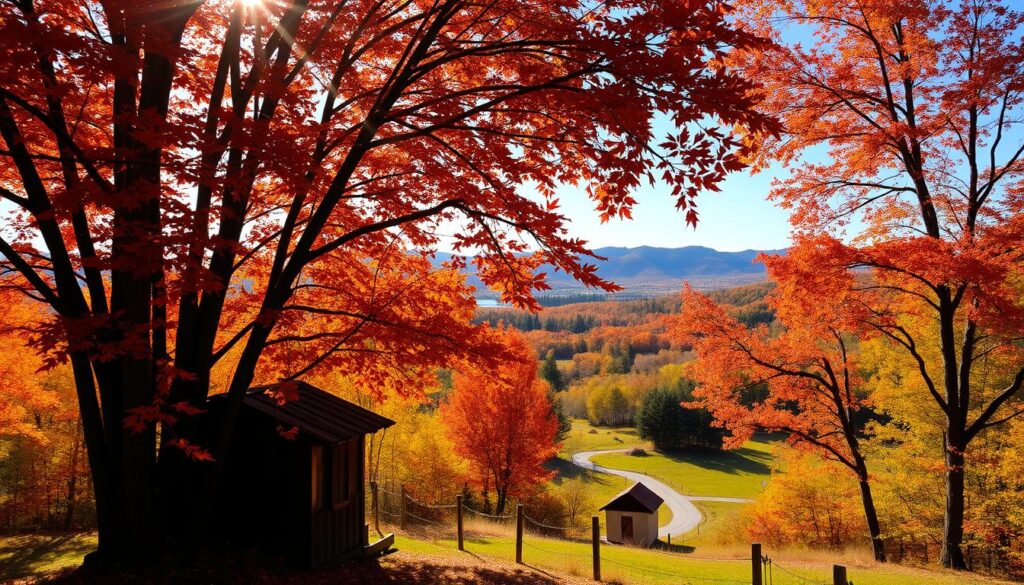
Vermont maple syrup is a top choice in the world of food. It’s known for its unique taste and quality. The state’s special geography makes it perfect for making the best maple syrup.
Several key factors make Vermont maple syrup stand out:
- Unique Climate Conditions: Vermont’s cold winters and mild springs create perfect sap flow conditions
- Rich Sugar Maple Forests: Dense maple tree populations with optimal genetic characteristics
- Generational Expertise: Sugarmakers with deep-rooted traditional knowledge
The terroir of Vermont adds to the syrup’s complex flavor. The soil, elevation, and microclimates all play a part. This makes each batch of syrup unique and loved by maple fans.
Vermont is serious about quality. The state has strict rules for making syrup. Every batch is tested and graded carefully. This ensures only the best syrup is sold.
“Our maple syrup is more than a product—it’s a reflection of Vermont’s natural heritage and craftsmanship.”
Vermont maple syrup is recognized all over the world. It has won many awards for its quality. This makes it a favorite among food lovers everywhere.
Organic Certification in Vermont Maple Syrup Production
Vermont’s maple syrup industry leads in organic production. It sets high standards for sustainable and eco-friendly syrup making. The focus on organic maple syrup shows respect for nature and traditional methods.
Certification Requirements
Organic maple syrup in Vermont meets strict USDA organic rules. Producers must follow these guidelines to get certified:
- No synthetic chemicals or pesticides in forest management
- Preservation of natural forest biodiversity
- Documented traceability of maple sap collection
- Regular independent forest inspections
Environmental Impact
The Vermont maple syrup organic certification is more than just a standard. It’s a complete approach to protecting forests and ecosystems. Sustainable methods keep natural habitats safe while producing top-quality syrup.
“Organic maple syrup is not just a product, it’s a commitment to environmental stewardship.” – Vermont Maple Producers Association
Sustainable Practices
Organic maple syrup producers in Vermont follow detailed sustainable practices:
- Carefully selecting and protecting maple trees during tapping
- Maintaining forest biodiversity
- Minimizing soil and water ecosystem disruption
- Protecting wildlife habitats
These efforts ensure each drop of organic maple syrup is a balance of human effort and nature’s preservation. Vermont is a top example of sustainable farming.
Best Vermont Maple Syrup Producers
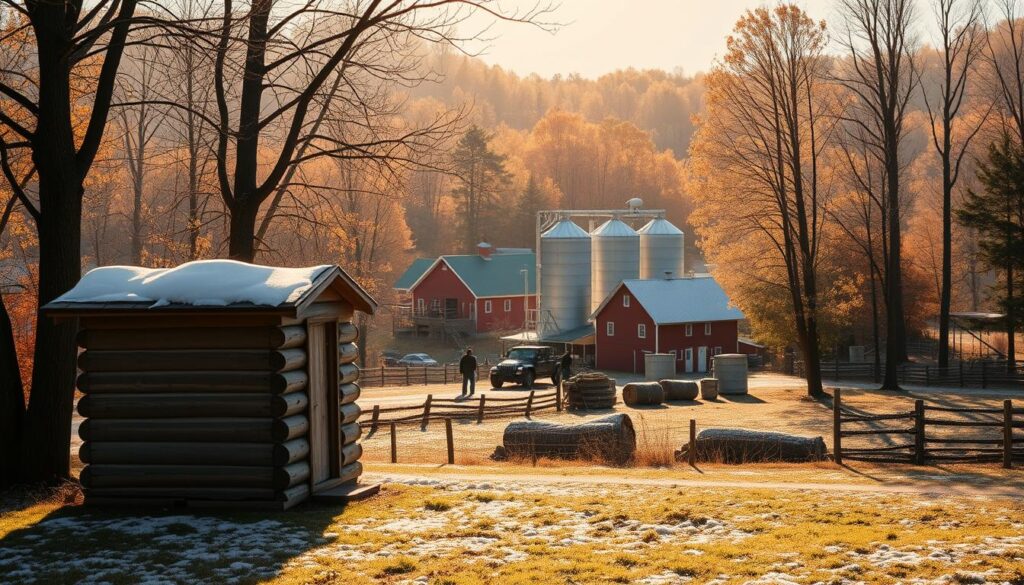
Vermont is home to some of the best maple syrup makers in the U.S. These sugarmakers turn the state’s forests into golden syrup. They show the highest level of craftsmanship in making syrup.
Many producers have gained fame for their high-quality syrup and traditional methods. A guide to authentic maple syrup highlights their skill.
- Maple Grove Farms: A historic producer known for consistent quality
- Butternut Mountain Farm: Specializing in organic Vermont maple syrup
- Green Mountain Sugar House: Pioneering sustainable production techniques
Each producer adds their own touch to their syrup, showing the unique flavors of their forests. This variety lets syrup fans try different tastes and styles.
| Producer | Specialty | Organic Certification |
|---|---|---|
| Maple Grove Farms | Classic Amber Syrup | Yes |
| Butternut Mountain Farm | Dark Robust Syrup | Yes |
| Green Mountain Sugar House | Golden Delicate Syrup | No |
For those who love maple syrup, visiting these Vermont producers is a must. It’s a chance to taste the region’s maple heritage. Each bottle tells a story of tradition and connection to the land.
Seasonal Production and Peak Harvesting Times
Vermont maple syrup production is a dance with nature. Timing and weather are key to making pure maple syrup. The sugaring season is a magical time for sugarmakers in Vermont.
The vermont maple syrup harvest happens in a short season. Sugarmakers watch the weather closely to collect sap. They know that getting it right is what makes their syrup special.
Weather Conditions Impact
Good sap flow needs the right temperature. The best conditions are:
- Nighttime temperatures below 32°F
- Daytime temperatures above 40°F
- Alternating freeze-thaw cycles
These changes make the sap flow better at certain times.
Harvesting Calendar
The season for vermont maple syrup usually starts in late February and ends in early April. The best time to harvest is a 4-6 week period. This depends on the local weather and climate.
- Late February: Season begins
- March: Peak production month
- Early April: Season concludes
Climate changes can change these times. Sugarmakers must adjust to keep making pure maple syrup.
Health Benefits of Pure Maple Syrup
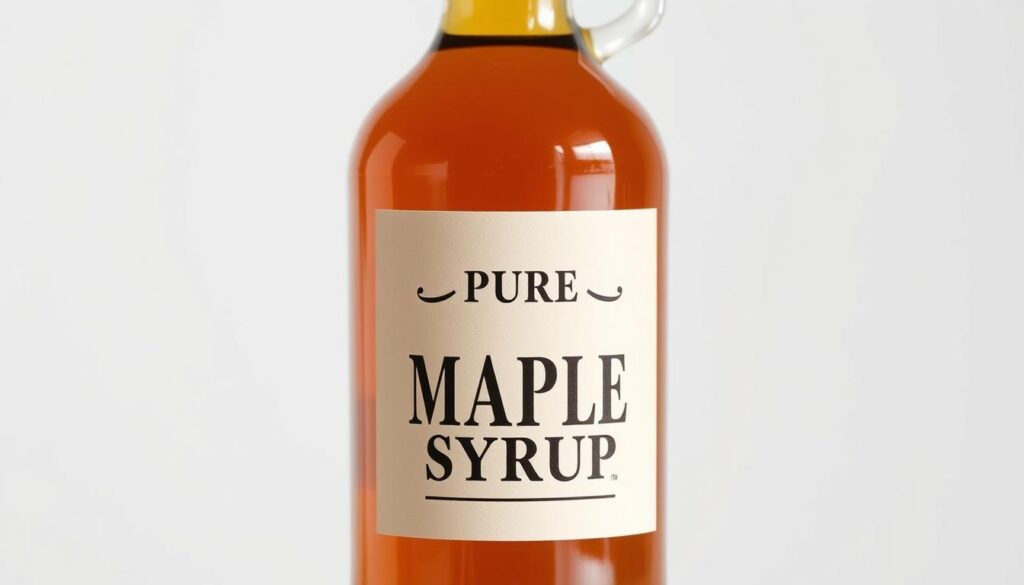
Vermont maple syrup is more than a tasty sweetener. It’s a nutritional powerhouse with surprising health benefits. Unlike refined sugars, it offers essential minerals and antioxidants that boost overall wellness.
The nutritional profile of pure maple syrup is truly impressive. A single tablespoon is packed with important nutrients:
- 0.58 milligrams of manganese
- 0.29 milligrams of zinc
- 20 milligrams of calcium
- 42 milligrams of potassium
Research shows that Vermont maple syrup contains up to 24 different antioxidants. These can protect cells from damage. Antioxidants like benzoic acid, gallic acid, and flavanols are found in it.
Vermont maple syrup has a lower glycemic index than refined sugar. This means it raises blood sugar levels more slowly. It’s a healthier choice for those watching their glucose levels.
“Maple syrup is nature’s sweet gift, more than just flavor—it’s a natural source of nutrition.” – Vermont Maple Experts
The health benefits of maple syrup go beyond nutrition. Some studies suggest it may:
- Reduce skin inflammation
- Support cellular protection
- Provide natural antibacterial properties
While maple syrup should be enjoyed in moderation, it’s a healthier choice than processed sweets. Its natural origins and nutrient profile make it a better option.
Culinary Uses and Maple Syrup Recipes
Vermont maple syrup makes simple dishes into amazing meals. It adds depth and richness to many recipes. Maple syrup recipes open up endless creative options for cooks.
Vermont maple syrup is more than just a breakfast topping. It’s used in many creative ways in cooking.
Traditional Applications
Maple syrup’s classic uses are loved by many. It’s used for:
- Drizzling over pancakes and waffles
- Sweetening breakfast oatmeal
- Glazing ham and bacon
- Creating traditional maple candies
Modern Culinary Innovations
Today’s chefs are getting creative with maple syrup. They’re making new and tasty flavor mixes. Innovative techniques include using maple syrup in:
- Marinades for grilled meats
- Craft cocktail ingredients
- Salad dressing bases
- Gourmet dessert preparations
Seasonal Recipe Ideas
Each season offers a chance to highlight maple syrup’s flavor. Winter is for warm dishes, while summer is for light ones.
- Autumn: Maple-roasted root vegetables
- Winter: Maple pecan pie
- Spring: Maple glazed salmon
- Summer: Maple vinaigrette for fresh salads
Trying out maple syrup recipes opens up a world of tasty possibilities. It celebrates Vermont’s maple syrup tradition.
Storage and Preservation Tips
Keeping pure maple syrup’s rich flavor means paying close attention to how you store it. Vermont maple syrup is a special product. It needs the right care to keep its quality and taste top-notch.
Choosing the right container is key. Glass or food-grade plastic is best for storing Vermont maple syrup. Stay away from metal containers, as they can affect the syrup’s natural compounds.
- Keep unopened pure maple syrup in a cool, dark pantry
- Refrigerate after opening to extend shelf life
- Seal containers tightly to prevent contamination
- Check for signs of mold or fermentation before use
Temperature is very important for keeping maple syrup fresh. Ideal storage temperatures range between 40-50°F. Refrigeration stops crystallization and keeps the syrup good for about a year.
For longer storage, freezing is a good option. Maple syrup can be frozen forever without losing its flavor. Just put it in a freezer-safe container, leaving room for it to expand.
Maple syrup lovers should always check its look and smell before using it. Fresh syrup should be clear and amber, with a sweet smell. Cloudy or bad-smelling syrup might be spoiled.
Pro tip: Always use clean utensils when serving maple syrup to prevent bacterial contamination.
Where to Buy Authentic Vermont Maple Syrup
Finding the best Vermont maple syrup is a fun journey. You can buy it online or check out local spots. Vermont has many ways to get this sweet treat.
Finding real Vermont maple syrup takes some effort. But, there are many trusted places to buy it.
Local Purchasing Strategies
People in Vermont can find maple syrup in several ways:
- Farm stands in rural Vermont communities
- Farmers’ markets throughout the state
- Specialty food stores in Vermont
- Local cooperative groceries
Online Purchasing Options
If you can’t visit Vermont, buying maple syrup online is a good option.
| Online Source | Unique Features | Shipping Details |
|---|---|---|
| Vermont Maple Syrup Direct | Certified organic selections | Free shipping over $75 |
| Artisan Maple Marketplace | Small-batch productions | Nationwide delivery |
| Farm-to-Table Syrup Co. | Single-source offerings | Expedited shipping available |
When buying Vermont maple syrup online, look for these signs:
- Organic certification
- Transparent sourcing information
- Grade and color specifications
- Packaging details
Pro tip: Always check the syrup’s origin to make sure it’s from Vermont.
Understanding Maple Syrup Pricing
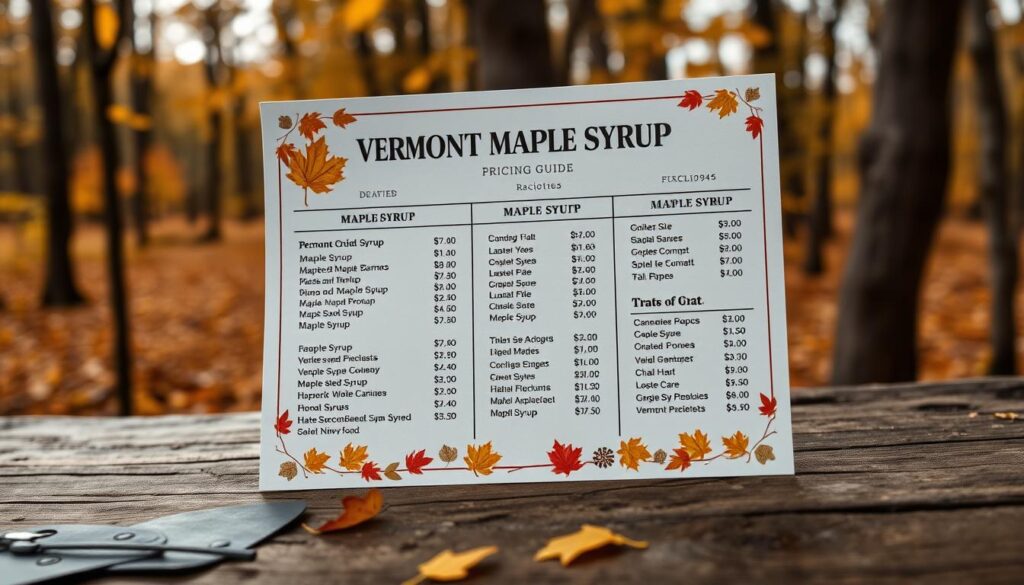
Buying maple syrup, like Vermont maple syrup, is a special treat. The price of pure maple syrup comes from many factors. These factors make it a unique and valuable product.
Several key elements influence the cost of authentic Vermont maple syrup:
- Labor-intensive production process
- Seasonal harvesting limitations
- Grading and quality standards
- Environmental conditions
Sugarmakers put a lot of time and effort into making high-quality maple syrup. They use special equipment, collect sap carefully, and process it with precision.
To help consumers understand pricing, here’s a breakdown of typical Vermont maple syrup costs:
| Grade | Price Range per Quart | Characteristics |
|---|---|---|
| Golden | $15-$20 | Delicate flavor, lightest color |
| Amber | $18-$25 | Rich, classic maple taste |
| Dark | $20-$30 | Robust, intense maple flavor |
Tip for buyers: Pure Vermont maple syrup typically costs more than artificial alternatives due to its authentic production and superior quality.
“The price reflects not just a product, but a tradition of craftsmanship passed down through generations of Vermont sugarmakers.”
When you buy maple syrup from Vermont, you support local farmers. You also enjoy a real culinary tradition. This tradition can’t be found in mass-produced products.
Vermont Maple Tourism and Experience
Vermont’s maple syrup industry invites visitors into its heart. They can dive into the rich culture and magic of maple syrup. Unique tourism experiences make Vermont’s sweet tradition come alive.
Maple Farm Tours: A Sweet Adventure
Visitors can see how maple syrup is made on farm tours in Vermont. These tours let guests get close to the syrup-making process. They can:
- Witness sap collection techniques
- Explore traditional sugarhouses
- Learn about maple syrup grading
- Sample fresh Vermont maple syrup
Seasonal Maple Festivals
Vermont celebrates its maple heritage with lively festivals. These events highlight the cultural importance of Vermont maple syrup. They offer unforgettable experiences for visitors.
| Festival Name | Location | Month | Highlights |
|---|---|---|---|
| Vermont Maple Festival | St. Albans | April | Maple syrup contests, cooking demonstrations |
| Maple Weekend | Statewide | March | Open sugarhouse tours, maple tastings |
| Maple Harvest Festival | Londonderry | March | Local artisan markets, maple products |
Travelers can dive into Vermont’s maple culture at these festivals. They get to experience the state’s beloved agricultural tradition up close.
Conclusion
Vermont maple syrup is more than a sweetener. It’s a symbol of a long-standing tradition and sustainable farming. From Vermont’s maple forests to the syrup-making process, it shows dedication and natural excellence. Understanding the differences between real and commercial maple syrup highlights the skill behind it.
The story of Vermont maple syrup goes beyond its taste. It connects families through generations, keeping traditional methods alive. Each bottle shows a commitment to the environment, local farming, and American culinary heritage.
For those who love food, health, and unique products, Vermont maple syrup is a special treat. It’s packed with nutrients, has complex flavors, and holds cultural value. Choosing pure maple syrup supports local farmers and keeps a centuries-old tradition alive.
Exploring Vermont maple syrup, you’ll find a story of passion, tradition, and perfection. Whether on pancakes, in recipes, or on its own, it delights and honors Vermont’s agricultural legacy.

